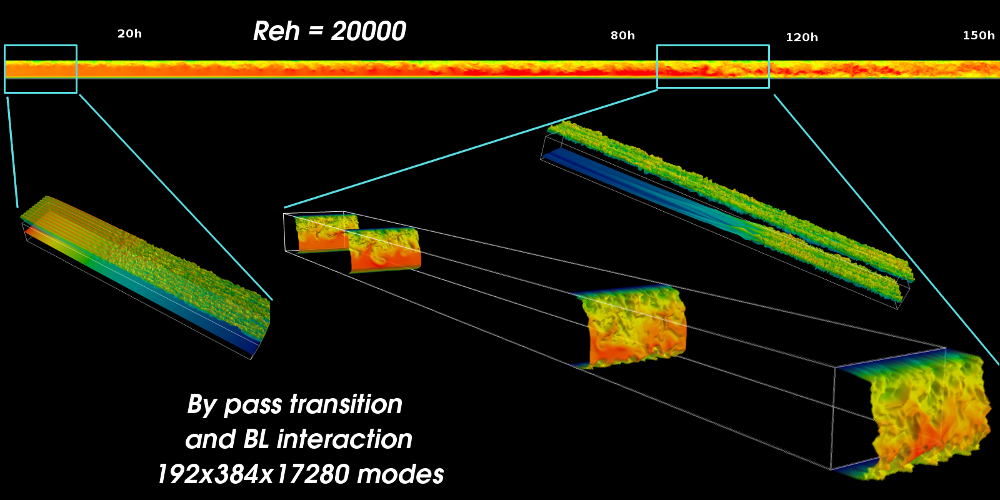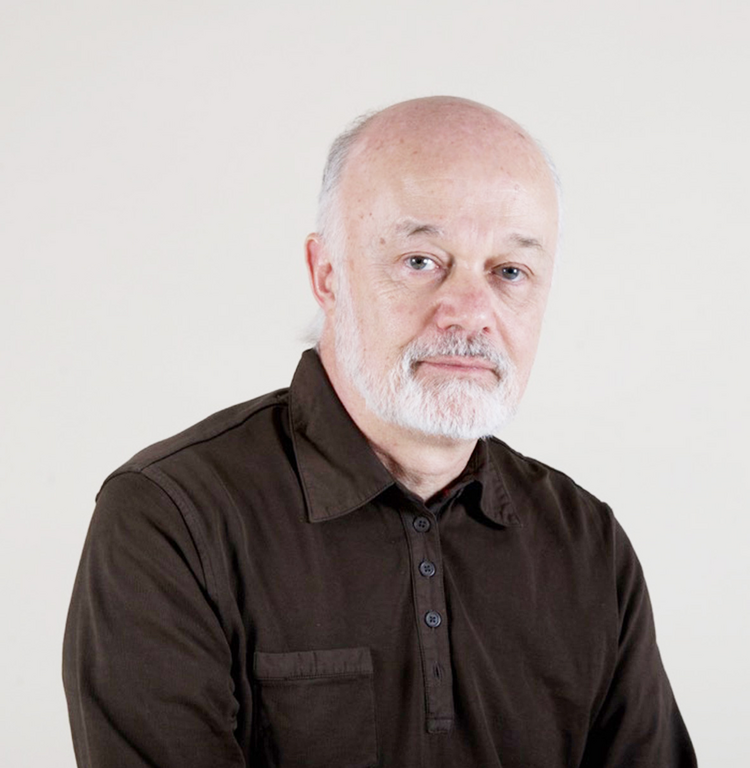NadiaSpectral
The computer code NadiaSpectral (M. Buffat, L. Le Penven)
NadiaSpectral is a computer code that simulates non-stationnary 3D flow between two walls. This code was initially developed during the PHD thesis of my student Henry Pascal in 1995, following an idea of Lionel LePenven, to study a wall-bounded Compressed Turbulence.The numerical method is based on a general orthogonal decomposition proposed by Le Penven et Buffat (2012) for solenoidal vector fields expressed in terms of projections of the velocity and vorticity fields on an arbitrary direction in space. For doubly-periodic flow with one direction of inhomogeneity (normal direction), Buffat et al. (Computer & Fluids 2011) derived an explicit form of this decomposition using the Helmholtz-Hodge theorem and showed that any divergence-free velocity field can be written as an L2 orthogonal sum of two solenoidal velocity fields depending on the normal velocity and vorticity components respectively. For wall bounded flow this decomposition is linked to the Orr-Sommerfeld and Squire modal decomposition of the linear stability theory (Buffat and Le Penven POF 2012).
- The NadiaSpectral code is based on this decomposition using a weak formulation of the Navier-Stokes equations in divergence-free subspaces. The approximation uses Fourier expansions in two directions and the Chebyshev basis proposed by Moser et al. (JCP 1983) in the third direction in order to satisfy the wall boundary conditions (Buffat et al. 2011). The code NadiaSpectral has been successfully used by Faouzi Laadhari (POF 2002,2007) to study turbulent channel flow by DNS using very large number of grid points (~100 million). The code has also been extended to simulated turbulent channel flow with solid particles (Ivana Vinkovic 2008)).
- A new version have been developped in order to run on the massivelly parallel computer of GENCI/PRACE (Blue Gene/ Curie ..) using more than tens of thousands of CPU-cores (Montagnier et al, IJNMF 2012) (see the presentation
 .
. - A PRACE European project ( PRACE 4th call) have been obtained to performed large simulations on top HPC plateforms in Europe (JUQEEN and SuperMUC in Germany)
By pass transition induced by boundary layer interactions in entrance channel flow
By-pass transition of the lower boundary-layer by interaction of the turbulent flow field generated after the upper boundary-layer transition triggered by the perturbation of an optimal mode at the entrance of the channel. Partial view near the channel entrance where growth and breakdown of streaks can be observed. Partial view from 100h to 120h (end section 150h) where the transition of the lower boundary-layer occurs (Buffat et al 2012).
Simulation of by-pass transition (L. LePenven, M. Buffat, A. Cadiou)
We simulate the development of laminar boundary layer on two parallel plates. The incoming Blasius like flow is perturbed outside the laminar boundary layer using optimal Orr Sommerfeld mode (Zaki Durbin JFM 2005, Schlatter et al Phys. fluids 2008) (umax = 4% ) These modes induce by non-linearity mechanism the transition of the laminar boundary layers through secondary streaks instabilities.The numerical simulations have been performed on the Linux clusters of P2CHPD (http://www.p2chpd.univ-lyon1.fr) at UCB Lyon 1, member of “Fédération Lyonnaise de Modélisation et Sciences Numériques” FLMSN (http://www.flmsn.univ-lyon1.fr)
- instantaneous velocity field in a plane parallel to the wall inside the boundary layer
visualization of the secondary instability of the streaks and transition to turbulence

-
instantaneous velocity field in a plane perpendicular to the 2 walls (the walls are at the top and the bottom of the figure)

- Instantaneous friction coefficient
The instantaneous friction coefficient is compared with the laminar Blasius law and the classical turbulent correlation. In that case the transition is clearly observed at Re[x]=150 000

References
- M. BUFFAT, L. Le PENVEN and A. CADIOU, “An efficient spectral method based on an orthogonal decomposition of the
velocity for transition analysis in wall bounded flow”, Computers & Fluids Volume 42, Issue 1, March 2011, Pages 62-72,

- H. PASCAL, “Etude d’une turbulence compressée et ou cisaillée entre deux plans parallèles: comparaison entre approche statistique et simulation des équations de Navier-Stokes instantanées”, thèse Ecole Doctorale MEGA ECL, Février 1996.
- M. N’DYAIE, “Etude par simulation DNS des écoulements compressés de proche paroi”, thèse Ecole Doctorale MEGA ECL Mars 2001
- H. PASCAL, M. BUFFAT, “Ecoulements turbulents à bas Reynolds cisaillés et/ou compressés simulés par méthodes spectrales”, 11e Congrés de Mécanique, Lilles, Septembre 1993
- H. PASCAL, M. BUFFAT, “Large Eddy Simulations of Turbulent Flows compressed and/or sheared between 2 walls on parallel computer using a divergence-free Spectral Galerkin method”, 3rd ECCOMAS Computational Fluids Dynamics Conference, Wiley ed., Paris, 9-13 septembre 1996.
- M. N’DIAYE, M. BUFFAT and L. LE PENVEN, Numerical Simulation and Modelling of a Wall-bounded Compressed Turbulence”, 4th International Symposium on Engineering Turbulence Modelling and Measurements, May 24-26, 1999, Corsica, France
- M. BUFFAT, “Code NadiaSpectral: theoretical manual”, internal report, LMFA UCB Lyon 1, 2009,

- M. BUFFAT, L. Le PENVEN and A. CADIOU, “An efficient spectral projection method on divergence-free subspaces for transition analysis in wall bounded flow “, technical report, LMFA UCB Lyon 1, 2009

- R. D. Moser and P. Moin and A. Leonard, “A spectral numerical method for the Navier-Stokes equations with applications to Taylor-Couette flow”, JCP 1983
